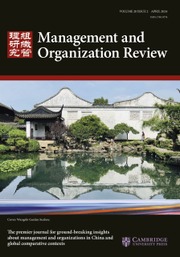No CrossRef data available.
Article contents
Family Dynamics and Entrepreneurship in China: An Introduction of the Dual Tuning Model of Temporal Rhythms
Published online by Cambridge University Press: 24 July 2025
Abstract
Family dynamics can significantly influence entrepreneurship, yet the temporal complexities of this relationship remain inadequately explored. This special issue addresses this gap by emphasizing the intricate interplay between internal family evolvability such as generational transitions and identity shifts, cultural continuity, and external adaptability to rapidly changing economic, institutional, and technological contexts in China. We introduce a dual tuning model that highlights how entrepreneurial and family firms (FFs) strategically synchronize their internal and external temporal rhythms to manage conflicts and optimize performance. This lead article reviews existing literature, articulates the dual tuning model, and synthesizes insights from the articles in this special issue to illuminate how Chinese FFs navigate tensions between evolving internal dynamics and external market demands. We conclude by identifying promising future research avenues that leverage this temporal perspective to deepen our understanding of family dynamics and entrepreneurship in China.
摘要
尽管家庭动态对创业活动具有深远影响, 但其中时间维度上的复杂性尚未得到充分探讨。本期特刊聚焦这一研究空白, 强调中国制度情境下家庭内部的代际传承、身份转变、文化延续等‘演化性’因素, 与经济、制度及技术环境的快速变化所带来的‘适应性’要求之间产生的复杂互动。我们提出时间节奏的‘双重调适’模型,以揭示创业型企业与家族企业如何战略性地协同其内外部节奏, 从而缓解冲突、提升绩效。本文作为特刊的导论性文章, 通过回顾相关文献, 系统阐述该理论模型, 并整合本期论文的主要研究结果, 呈现了中国企业如何在内部动态演进与外部市场压力之间实现动态平衡。最后, 我们指出未来值得拓展的研究方向, 倡导从时间视角深化对中国家庭动态与创业关系的理解。
Information
- Type
- Perspectives
- Information
- Management and Organization Review , Volume 21 , Special Issue 2: Special Issue on ‘Family Dynamics and Entrepreneurship in China’ , April 2025 , pp. 180 - 195
- Copyright
- © The Author(s), 2025. Published by Cambridge University Press on behalf of International Association for Chinese Management Research.

